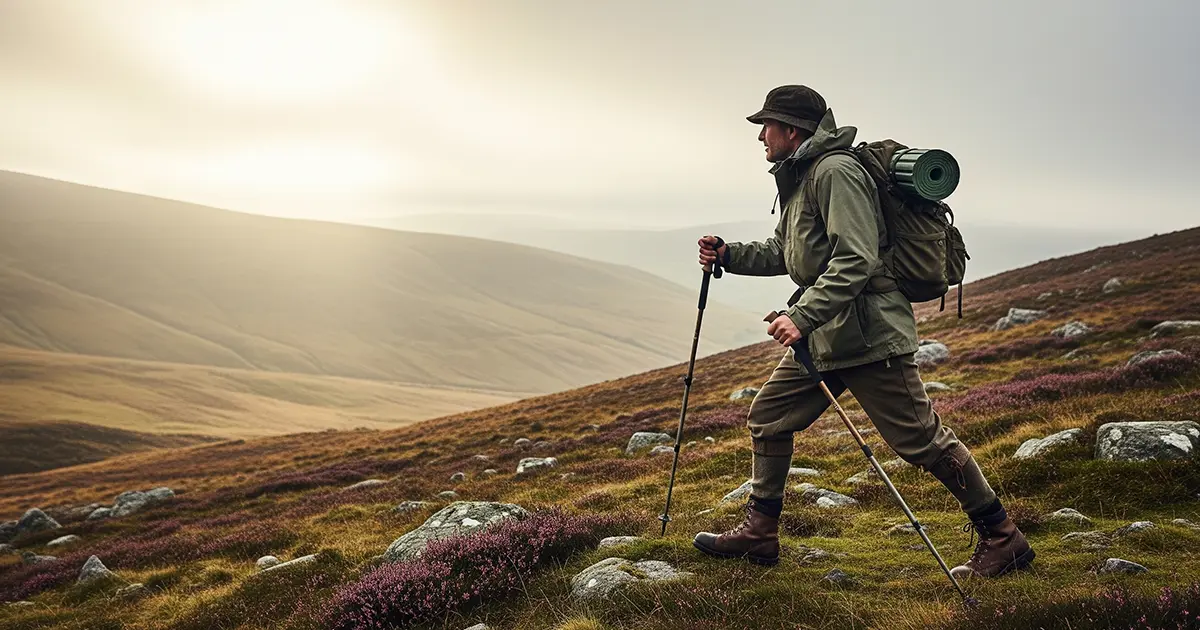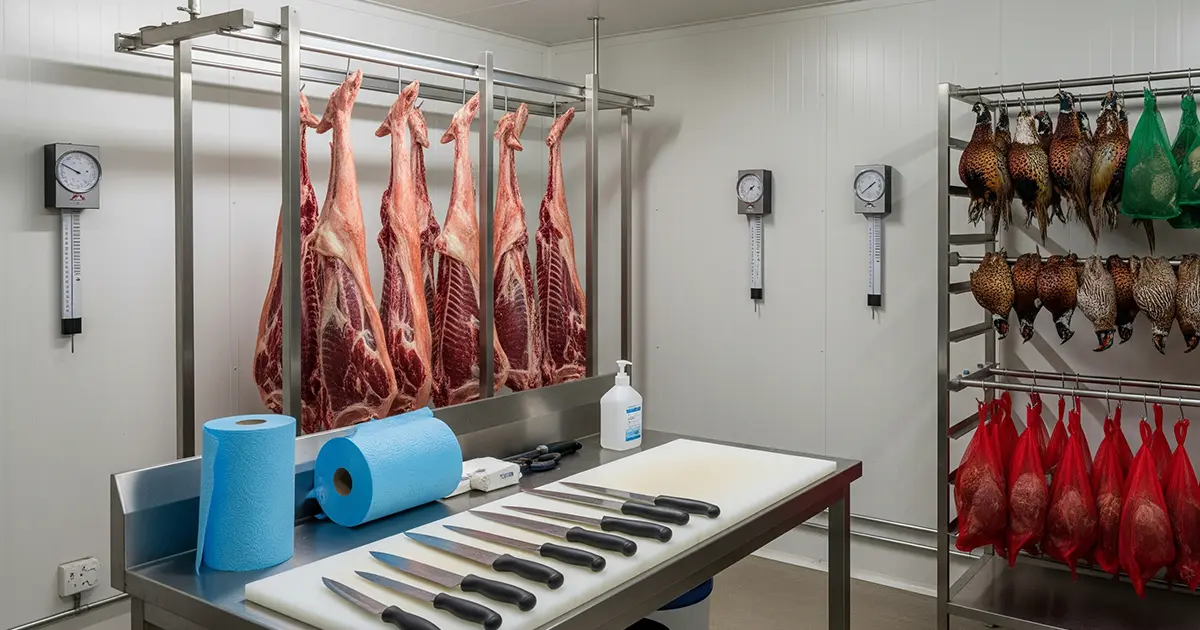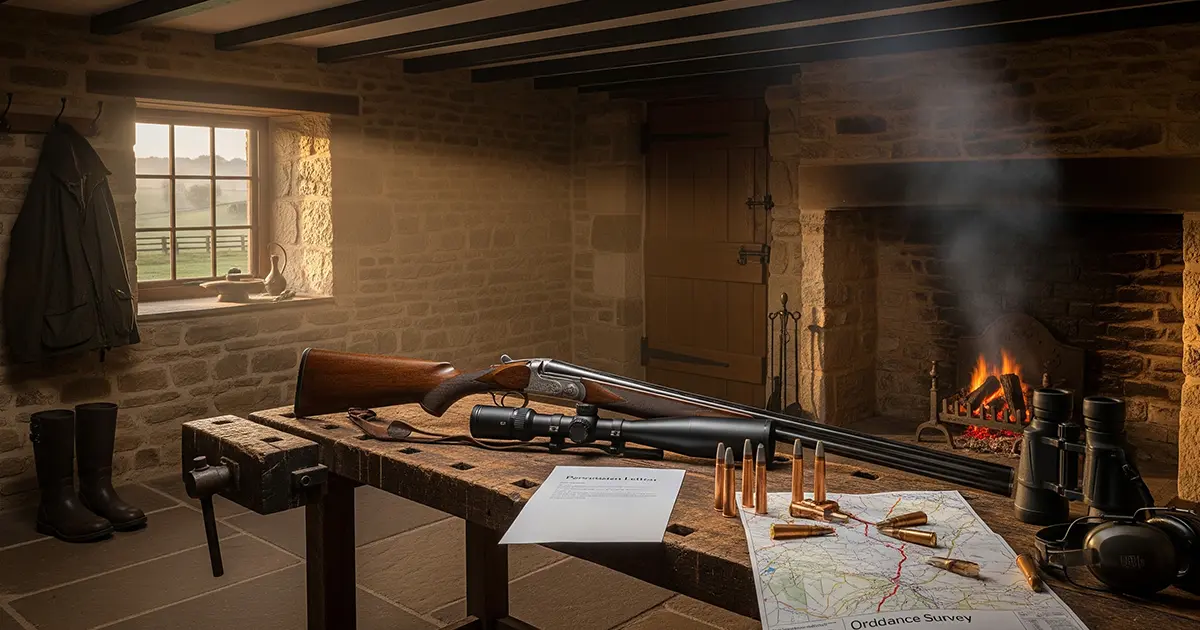A proper day on the ground can mean long miles over heather and peat, wet saltmarsh slogs, steep climbs, rapid drops to kneel or prone, then a steady carry out. That mix asks for an engine, strong hips and shoulders, decent balance, and feet that stay comfortable for hours. This guide brings the essentials together, blending NHS and UK mountain guidance with field know-how, so you turn up ready and get home in one piece.
“A level of fitness is required for deer stalking on the open hill, it is not uncommon to walk for 15 miles in one day.” Country Sport Scotland
Start with the right weekly baseline
The UK standard is simple: build to at least 150 minutes of moderate aerobic activity each week, or 75 minutes vigorous, plus muscle-strengthening on two or more days. Spread it out, keep it consistent. nhs.uk, GOV.UK
How hard is “moderate”? The NHS uses the talk test: you should be able to talk in sentences, but not sing. Save “only a few words between breaths” for vigorous work. nhs.uk
Practical tools that help you stick with it:
- Brisk ten-minute walks count and add up fast. nhs.uk
- Couch to 5K is a gentle nine-week plan that alternates walk and jog, builds gradually, and includes rest days. nhs.uk
- Active 10 nudges daily brisk walking, with recent research showing a meaningful bump in brisk minutes after download. Nature, University of Cambridge
Endurance that transfers to the hill and marsh
Train the way you move in the field:
- Brisk undulating walks or rucksack hikes two times a week, then a longer steady outing at the weekend.
- Stairs, step-ups or treadmill incline sessions if you live on the flat. The BMC suggests treadmill incline, stairs, and fast walking when you have no hills to hand. British Mountaineering Council
On intensity days, work up short hills or stair flights, walk back down, repeat. Keep breathing controlled, posture tall, and stride short on climbs. British Mountaineering Council
Strength that pays off under a pack and a gun
Twice weekly, cover all major muscle groups. Prioritise movements that mirror field tasks:
- Legs and hips: squats or split squats, step-ups, hip hinge.
- Back and core: rows, loaded carries, planks.
- Shoulders: presses and pulldowns or rows, plus a few minutes of rotator cuff control.
NHS guidance is clear that strengthening work is required alongside your aerobic minutes. nhs.uk
Shoulders that handle repeated gun mounts
Pain usually comes from overloaded, under-conditioned tissue. The good news, gentle progressive exercises improve strength and reduce pain in rotator cuff related shoulder problems. Add light-band rotations, raises and controlled arm circles to each strength day. Musculoskeletal Matters, Kingston and Richmond NHS
Warm up before you train or step off
Five to ten minutes is enough: brisk marching, stair steps, easy lunges, arm circles, a few slow gun mounts or rucksack hoists. Warm muscles move better and are less likely to complain. nhs.uk, NHS inform
Save your knees on long descents
Poles help on downhills. Multiple biomechanics studies report reduced joint moments and forces around the knee when using trekking poles on declines. Learn basic pole technique, plant lightly in front, shorten your stride, and let the poles share the braking load. PubMed
“A wading stick is vital for walking on the marsh.” That advice from BASC applies doubly in the dark or on soft ground. BASC
Balance, ankles and uneven ground
Heather, tussocks and peat hags punish weak ankles. Balance work and single-leg drills improve dynamic stability and cut sprain risk in people with chronic ankle instability. Start with single-leg stands near a wall, progress to eyes-closed holds and gentle hops. PMC, ScienceDirect
Feet first: fit, socks, and blister prevention
Sort your feet before the big day:
- Boot fit matters most, especially for steep or uneven ground. Mountain training guidance favours boots with support once terrain turns awkward. mountain-training.org
- Prevent blisters: well-fitting footwear, moisture-wicking sports socks, break new boots in with short walks, treat hot spots early. nhs.uk, NHS inform
- Dry and layer management: on multi-day trips, dry socks and boots overnight, and consider taping known hot spots. services.thebmc.co.uk
Carrying out without wrecking your back
Plan the lift, keep the load close, avoid twisting, and share heavy jobs. The HSE puts it plainly: “The law does not set specific weight limits.” Technique and context drive risk, so reduce distance, improve grip, and keep the load hugged in. HSE
Hydration, kept very simple
Aim for 6 to 8 cups of fluid daily, more when you are active for long periods or in warm weather. Water, lower fat milk and sugar-free drinks, including tea and coffee, all count. Check you are on track by aiming for pale straw-coloured urine. nhs.uk
Navigation and marsh-specific safety
Do not rely only on a phone. Carry paper map and compass, practise bearings, and know how to work in poor visibility. Ordnance Survey’s advanced guides are an excellent refresher. OS GetOutside
Wildfowling adds moving water and soft ground. Check local tide tables, carry a waterproof watch for timing, layer for the wind, and use a wading stick to test depth and mud. BASC, BTCK Storage
A realistic six to eight week build
Weeks 1 to 2
- Two brisk 30 minute walks on rolling ground, one 60 minute easy hike.
- Two 25 to 35 minute strength sessions covering legs, hinge, push, pull, carries, plus 5 minutes shoulder cuff work.
- One 10 minute balance session, single-leg holds and step-downs.
Weeks 3 to 4
- Add a short hill or stair session each week, 6 to 8 repeats at steady effort.
- Strength sessions progress slightly, add weight or a few reps.
- Increase long hike to 75 to 90 minutes with a light pack.
Weeks 5 to 8
- Keep two endurance days and the long hike.
- Add gentle downhills with poles to learn braking.
- Maintain twice weekly strength, progress carries and hip hinge, and keep the cuff routine in.
- Taper the final 3 to 4 days before your booking.
Field notes from David, The Instinctive Shooter
- Gun mounts without strain: do ten slow mounts, rest, repeat for two to three sets during the warm up. Pair this with light band rotations to wake the cuff. It keeps shoulders honest across a long day.
- Rucksack discipline: pack sits on hips, not shoulders. If the belt is loose you will feel it in your neck and upper back by lunchtime.
- Feet care is proactive: at the first sign of rubbing, stop, dry the area, tape it, and change socks. Do not soldier on for “just another drive.”
Helpful kit we can fit and explain in store
Boots and socks that suit your foot shape and route choice, poles sized to your height, slings and recoil pads that spare your shoulders, and packs that carry on the hips rather than the neck. Bring your current kit to The Instinctive Shooter and we will make small tweaks that save big discomfort later.
References at a glance
- Country Sport Scotland on hill stalking days and fitness demands. Country Sport Scotland
- NHS physical activity guidance, talk test, walking benefits, warm ups, hydration. nhs.uk
- NICE low back pain, activity-led management. NICE
- HSE manual handling principles.
- BMC training ideas when you lack hills, and boot guidance for uneven terrain. British Mountaineering Council, mountain-training.org
- Trekking poles reduce knee loads on downhills. PubMed
- Balance training improves ankle stability in chronic instability. PMC
- Shoulder rehab messages from NHS services. Musculoskeletal Matters
- OS navigation techniques for poor visibility. OS GetOutside
- BASC wild-fowling code and tide planning. BASC, BTCK Storage
- Active 10 and Couch to 5K programme details and evaluation. Nature, University of Cambridge, nhs.uk
Field Fitness Questions Answered
How Fit Do I Need To Be For A Stalking Trip In The UK?
Open hill stalking can involve walking many miles across rough, steep ground. If you can manage two brisk 30-minute walks during the week and a longer 60 to 90-minute outing at the weekend without struggling, you are on the right track.
What Training Can I Do If I Live Somewhere Flat?
If you have no hills nearby, stair climbing, treadmill incline walking and weighted step-ups are solid alternatives. The British Mountaineering Council recommends these as substitutes when preparing for hill days.
How Can I Prevent Knee Pain On Long Descents?
Trekking poles reduce pressure on the knees by sharing the braking force. Studies show they significantly lower joint load when walking downhill, especially with a pack.
What’s The Best Way To Avoid Blisters On A Shoot Day?
Break in new boots gradually, use moisture-wicking socks, and deal with hot spots before they turn into blisters. The NHS advises ensuring good fit and dryness, and mountain training bodies suggest taping problem areas early.
Do I Still Need A Map If I Have A GPS App?
Yes, paper map and compass are still essential. Ordnance Survey stresses the importance of traditional navigation in poor visibility, with the phone used as backup rather than the only tool.
How Much Should I Drink During A Long Day Outdoors?
The NHS recommends 6 to 8 cups of fluid daily, with more needed on active or hot days. Tea and coffee count, so long as you avoid excess sugar, and the best guide is aiming for pale straw-coloured urine.
What Strength Training Actually Helps In The Field?
Focus on legs and hips for climbing and stepping, back and core for stable carries, and shoulders for repeated gun mounts. Twice weekly full-body sessions that include squats, hip hinges, rows and carries match NHS guidance and field demands.




